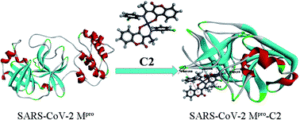We are very pleased to introduce Professor Zoran Marković (University of Kragujevac), corresponding author of the paper ‘Several coumarin derivatives and their Pd(ii) complexes as potential inhibitors of the main protease of SARS-CoV-2, an in silico approach‘. His article has been very well received and handpicked by our reviewers and handling editors as one of our September HOT articles. Zoran told us more about the work that went into this article and what he hopes to achieve in the future.
His article is also part of the coronavirus collection – all Royal Society of Chemistry articles on coronavirus research can be found here and are freely available until 1st January 2021. You can find more HOT articles in our online collection.
Could you briefly explain the focus of your article to the non-specialist (in one or two sentences only) and why it is of current interest?
In these challenging times of COVID-19 pandemics, it is of utmost interest to understand better the effects of various drugs on the virus and continue investigating new drugs. In our contribution, three molecules synthesized in our laboratory along with their Pd(II) complexes were theoretically analyzed as potential therapeutics and their effect compared to two already approved drugs, cinanserin, and chloroquine. This paper is of current interest because it allows scientists to obtain valuable data on structural parameters of molecules that could bind to the proteins of the virus and inhibit their action.
How big an impact could your results potentially have?
The theoretical predictions of the action of new therapeutics are an important step in any drug discovery as they save a significant amount of time and money. The impact of our research lies in the fact that coumarin derivatives, as naturally occurring compounds, and their palladium complexes were investigated for the first time as possible therapeutics and it was shown that they bind more tightly to the important protein of the virus than approved drugs. Special emphasis is put on the structural parameters governing stability which could lead to the prediction of structural features of new reactive drugs.
Could you explain the motivation behind this study?
The motivation for the research came from our current results on the synthesis of various coumarin derivatives and their transition metal complexes. The structures of obtained derivatives show similarities to those of approved drugs: the presence of chlorine atom, delocalized structure, two aromatic rings, etc. Therefore, we decided to perform a theoretical study using the novel docking and dynamics techniques on the recently solved structure of the SARS-CoV-2 Mpro protein and compare results to the approved drugs.
In your opinion, what are the key design considerations for your study?
The key considerations were the structural similarities between drugs and molecules obtained in our lab. After the results were obtained the special emphasis was put on the determination of intermolecular interactions that responsible for the binding of the molecules to the active position of the protein.
Which part of the work towards this paper proved to be most challenging?
The most challenging part was the analysis of the molecular interactions responsible for the difference in reactivity of approved drugs and our coumarin derivatives, as this required special attention to details and all of the amino acids of the active pocket.
What aspect of your work are you most excited about at the moment?
We are very excited that the molecules obtained in our laboratory show higher reactivity towards SARS-CoV-2 proteins, especially their metal complexes with Pd(II) which proved to be less toxic than other transition metals.
What is the next step? What work is planned?
The next step includes the development of the new synthetic routes for the coumarin derivatives that possess other structural moieties similar to the approved drugs and transition metal complexes with other non-toxic metals. This would be beneficial as structure-activity analysis would allow the extraction of new data for the structural features important for reactivity. Also, if the situation allows, the experimental research will commence to verify the results of theoretical studies.
Several coumarin derivatives and their Pd(ii) complexes as potential inhibitors of the main protease of SARS-CoV-2, an in silico approach
Dejan A. Milenković, Dušan S. Dimić, Edina H. Avdović and Zoran S. Marković
RSC Adv., 2020,10, 35099-35108
DOI: 10.1039/D0RA07062A, Paper
 Submit to RSC Advances today! Check out our author guidelines for information on our article types or find out more about the advantages of publishing in a Royal Society of Chemistry journal.
Submit to RSC Advances today! Check out our author guidelines for information on our article types or find out more about the advantages of publishing in a Royal Society of Chemistry journal.
Keep up to date with our latest HOT articles, Reviews, Collections & more by following us on Twitter. You can also keep informed by signing up to our E-Alerts.











